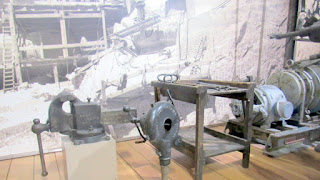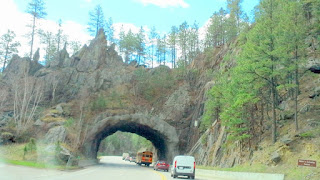
May 8, Tuesday, our first planned sight seeing day. We started early as we had no idea how long it would take to see Mt. Rushmore. On our travels down the road we saw this awesome wooden bridge , to find out that our next turn took us over it. We also had to go through this tunnel to get to Mt. Rushmore.
Mt Rushmore sure has been enhanced since the times we were there for a visit 50 years ago. However, we did have more than enough time to see the history as well as the mountain and movie.
The sculptor, John Gutzon Borglum, did not initially intend to use blasting on Mt. Rushmore, saying that it was unnecessary and unsafe. But after three weeks of drilling and plugging, it became apparent that the job would take too long and some experimental blasting was tried. It soon became a daily occurrence. Over all, 90 percent of the carving was done by blasting.
Borglum was born in 1867 in St. Charles, ID to Mormon Danish immigrants. He later studied art in Paris and New York and became a well-known portrait sculptor. He began with a Confederate memorial on Stone Mountain in Georgia. In 1925 the Federal and state legislation authorized the carving of a memorial in Black Hills. Borglum then quit the Stone Mountain project and went to South Dakota.
The location was chosen because of it's size, orientation to the morning and midday light, and the Fine-Grained Granite. Borglum proposed US presidents as the subjects. Thus, George Washington, Thomas Jefferson, Theodore Roosevelt and Abraham Lincoln.
Noses are about 20 feet long, eyes about 11 feet wide and mouths about 18 feet wide. About 400 laborers worked on the memorial and there were few injuries and no deaths. Hourly pay ranged from 35 cents to $1.50 and they came from the ranks of the unemployed.
The original cost was $989,992.32 of which about 85 percent was federal funds. About 450 tons of rock was blasted from the mountain. The 1990's re-development cost $56 million. Cracks are patched as needed with silicone sealant and the faces were pressure washed for the first time in 2005.
Check out these pictures from the displays:
 |
| Some of the tools used. |
 |
| The harness that each carver wore. |

It was an awesome tour!! On the way back to our car we noticed the white goats off in the woods to the side of the walkway.
 |
| Beautiful!! |
We still have plenty of time so now we leave and head to see the Crazy Horse Monument.
This is the monument as we both saw it about 50 years ago. But they are now carving a mountain as the U.S. did. It is still located at the same place, but they have expanded with much room to add more historical items and pictures.
Approaching the Monument -
When we drove into the parking area we found many of these cars. Seems that a Model A club was checking out the Memorial also.
The sculptor, Korczak Ziolkowski was born in Boston of Polish descent. He is a self taught, renowned sculptor, gaining recognition at the 1939 World's Fair which attracted the attention of Chief Henry Standing Bear who invited him to the Black Hills to carve Crazy Horse.
Ziolkowski died in 1982, but his wife and ten children have continued the project. Wife, Ruth, died in 2014.
The mission of Crazy Horse Memorial Foundation is to protect and preserve the culture, tradition, and living heritage of all North American Indians.
It is also an important part of this countries Native American history. I've been reading Wagons West series of 25 books, so I am in tune with that history also and really enjoy it!! Gary reads many westerns also. Now the stone mountain!
 |
| If you can see the white lines on the right side of the mountain, we think that is is the beginning of the outline for the horse. It will be the same as the white sculpture. |
Now some pictures from their museum - -
 |
| A dress made from hide and beads. Beautiful! |
 |
| Baby moccasins. |
 |

 |
| Unusual white female buffalo calf. Read the "Miracle" history. |
 |
I also had to take a picture of this Boy Scout tribute which honors Indian history.
They had a very nice restaurant there as well and the menu and prices were not bad. So we took the time to rest and eat before returning home. The one end of the restaurant was all windows looking out upon the mountain. It was far enough away from the mountain that we could not see any workers. They did use heavy equipment, but we could not see that either. They may have been working on the back side. I suggested that Gary use a quarter and use one of the viewfinders, but he did not have a quarter and blamed it on me for using them all on laundry!! Poor guy!!














No comments:
Post a Comment